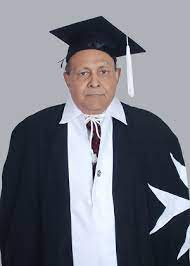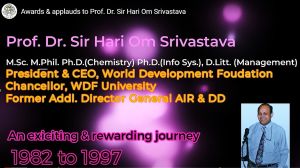Prof Dr Sir Hari Om Srivastava
Prof. Dr. Sir Hari Om Srivastava -profileeverypedia is an Indian Scientist. He is President of World Development Foundation (WDF, WDFINDIA), India. He is Chancellor of WDF University for SDG2030 and visiting Professor of several Universities and Colleges. He has published more than 150 research papers in national and international journals and also authored several books. He was bestowed with the honor Knights Hospitaller on 29 Nov. 2017. He has been selected as one of top ten Indian Scientists by Indian amino community, USA.Top Indian Scientists
Prof. Dr. Sir Hari Om Srivastava, K.St.J, Knight Hospitaller
Order of Knights of the Hospital of Saint John of Jerusalem
Birth: 21 May 1947, Ghazipur, Uttar Pradesh, India
Alma mater Doctor of Philosophy (Information System) (1969),
Birla Institute of Technology & Science, Pilani, India, D.Litt.
Wife: Dr. Chandra Rashmi Srivastava, Daughters: Swati, Aprajita<
Education
Sir Srivastava received following education.
| Sl. No. | Degree | University | year |
|---|---|---|---|
| 1 | Master of Science in Physics | Deen Dayal Upadhyay Gorakhpur University, India | 1967 |
| 2 | Graduation in Electronics & Telecom | Institution of Electronics and Telecommunication Engineers, India | 1970 |
| 3 | Doctor of Philosophy (Chemistry) | Veer Bahadur Singh Purvanchal University Jaunpur, India | 1996 |
| 4 | Master of Philosophy (Information System) | Birla Institute of Technology & Science, Pilani, India | 1997 |
| 5. | Doctor of Philosophy (Information System) | Birla Institute of Technology & Science, Pilani, India | 1999 |
Professional life
Sir Srivastava is a consultant to Gerson Lehrman Group [1], a New York-based consulting firm that is a platform for professional learning and connects business people to experts to provide solutions. He is the former Additional Director General of All India Radio and Doordarshan. He worked as Commonwealth Expert in 1990 and International Telecommunication Union (ITU) Expert in 1991. Currently, he is working through WDF to enrich and empower the lives of poor and marginalized people in the world by using the technology of mass media and ICT for training and education of the people in the areas of health, agriculture, education, and entertainment. His areas of interest are Information Systems, Digital storage, Multimedia Broadcasting, and Broadcast applications for the enrichment of life of the poor and marginalized. He is keenly associated with the expansion of Community Radio Station (CRS) and other means of new media for education and social causes.
Awards and honors
Sir srivastava received following honors and awards.
| Sl. No. | Awards & Honors | Authority/Organization | year |
|---|---|---|---|
| 1 | Knights hospitaller (K.St.J) | Most Venerable Order of the Hospital of Saint John of Jerusalem | 2017 |
| 2 | Doctor of Letters (Honoris Causa) | KEISIE International University, South Korea | 2017 |
| 3 | Ghazipur Gaurav (Pride of birth place) | 2009 | |
| 4 | Marquis Who's Who in the World | 2001 | |
| 5. | Prof S N Mitra Memorial Award for "outstanding contribution and leadership role in radio broadcast science and technology during the last 10 (ten) years" | Institution of Electronics and Telecommunication Engineers (India) | 1999 |
| 6. | International Who's Who | 1998 | |
| 7 | Engineering Excellence Award for the years | Asia-Pacific Broadcasting Union, Malaysia |
1984,1985, 1986,1987, 1988 1990. |
| 8 | Hoso Bunka Foundation Scholarship | NHK, Japan | 1987 |
| 9 | Commonwealth Scholarship | Royal Instititute of Mangement, London | 1984 |
Technology Forecast
- Roadmap of Broadcasting in India,(1997), IETE TECHNICAL REVIEW. 14 (4/5): 283–290.
- Communication in the Next Millennium, Police Communications,(January 2000).India: Business Inn
- BROADCASTING TO NETCASTING, (1998), IETE TECHNICAL REVIEW. 15 (6): 467–469.[8]
- Broadcasting in 2020: A Prediction, (2003). IETE TECHNICAL REVIEW. 20 (4): 369–375.[9]
- Broadcasting in the cyberspace, (1996).IEEE transactions on consumer electronics. 42 (4): 9070913.
- Changing Face of Radio, (2002). Electronics information & planning. 29 (10/11): 368–371.
- FM Radio: Focus shifts to spectrum planning, exchange4media.com. Sep 4, 2004.
- India set to become the 'biggest radio market' in the world, Deutsche Welle News. Oct 21, 2011.[10]
- Mapping Digital Media: India
Selected Published works
- Data-Driven Knowledge Agriculture: A Paradigm Shift for Enhancing Farm Productivity & Global Food Security Global Journal of Science Frontier Research: A Physics and Space Science, Volume 23 Issue 1 Version 1.0 Year 2023, Online ISSN: 2249-4626 & Print ISSN: 0975-5896
- Interactive TV Technology and Markets, Interactive TV Technology and Markets, Norwood MA 02062: Artech House Inc. p. 395.
- Broadcasting in 2030: Crystal Gazing. European Journal of Applied Sciences, 9(6), 453–462. https://doi.org/10.14738/aivp.96.11385 Link to this article: Broadcasting in 2030: Crystal Gazing. or Broadcasting in 2030: Crystal Gazing
- Broadcast Technology: A Review, Gyan Publishing House, New Delhi,. p. 329. ISBN 9788121207003.[4]
- Prasaran Takniki, Kal, Aaj aur Kal, a book written in Hindi, New Delhi: BPB Publications.[5]
- On-line broadcast archives for interactive video, Broadcasting, IEEE Transactions on. 43 (3): 288–308. doi:10.1109/11.632930 [6]
- Maintenance Strategies for Broadcast Organisations, Asia-Pacific Broadcasting Union (135): 3–12
- History of Radio Broadcasting in India [7]
- Expert System for Equipment Specific Information System (ESIS),(April 1996), International Telecommunication Union, HRDQ. 63: 33–34.
- A System Approach to Replacements in A.I.R, (10 July 1985). Asia-Pacific Broadcasting Union (99): 3–10
- Simulation of Nickel using DMSO/ Amide baths, (October 1995). Electrochemical Society of India. 4. 44: 157–161.


